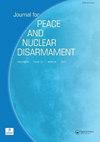Strategic Risk Management in Southern Asia
IF 1.4
Q4 INTERNATIONAL RELATIONS
引用次数: 0
Abstract
ABSTRACT Strategic stability at the China-India-Pakistan trijunction remains tenuous. The two dyads have endured conflicts over ideology, territorial disputes and power rivalry. Though drivers of conflict vary in each dyad, common aspirations and history of cooperative security agreements are worthy foundations for managing future strategic risks in Southern Asia. While each state in the strategic triangle faces nested security dilemmas, new sources of instabilities are compounding the strategic trilemma. Recent India-Pakistan (2019) and China-India (2020) military crises exposed the potential for multi-domain crisis escalation in future conflicts. Strategic risks increase either due to escalation dynamics in conflicts and/or inadvertence due to technical failures and incidents. This essay identifies three key strategic risks. First, faulty assessment of intentions and capabilities could lead to dangerous actions and counteractions. Second, nuclear-conventional entanglement of delivery systems may increase chances of blundering into accidental wars, as respective doctrines become murkier, communications become lesser, and military crises become more frequent. Third, fusion of accurate missiles systems with the emergent technologies is enabling cross-domain deterrence capabilities and providing decision-makers with multiple options to take greater risks during an evolving crisis. This article proposes that the three states consider new strategic risk-reduction measures through a series of multilateral and bilateral strategic dialogues at the Track-I and Track-II levels, and establish “strategic risk-reduction centers” customized to the Southern Asian strategic environment. These centers would function as central clearing house for all past and future agreements and act as nodal points for preventing misinterpretation or tragic incidents.南亚战略风险管理
中印巴三国的战略稳定依然脆弱。这两个阵营在意识形态、领土争端和权力竞争方面一直存在冲突。尽管冲突的驱动因素各不相同,但共同的愿望和合作安全协议的历史是管理南亚未来战略风险的重要基础。虽然战略三角中的每个国家都面临着根深蒂固的安全困境,但新的不稳定因素正在加剧战略三难困境。最近的印巴(2019年)和中印(2020年)军事危机暴露了未来冲突中多领域危机升级的可能性。战略风险的增加可能是由于冲突的升级和/或由于技术故障和事件的疏忽。本文确定了三个关键的战略风险。首先,对意图和能力的错误评估可能导致危险的行动和反击。其次,随着各自的理论变得更加模糊,通信变得更少,军事危机变得更加频繁,核常规运载系统的纠缠可能会增加陷入意外战争的可能性。第三,精确导弹系统与新兴技术的融合正在实现跨域威慑能力,并为决策者提供多种选择,以便在不断演变的危机中承担更大的风险。本文建议三国通过一系列一轨和二轨多边和双边战略对话,考虑新的战略风险降低措施,并建立适合南亚战略环境的“战略风险降低中心”。这些中心将作为所有过去和未来协议的中央结算所,并作为防止误解或悲剧事件的节点。
本文章由计算机程序翻译,如有差异,请以英文原文为准。
求助全文
约1分钟内获得全文
求助全文
来源期刊

Journal for Peace and Nuclear Disarmament
INTERNATIONAL RELATIONS-
CiteScore
1.30
自引率
0.00%
发文量
36
审稿时长
12 weeks
 求助内容:
求助内容: 应助结果提醒方式:
应助结果提醒方式:


